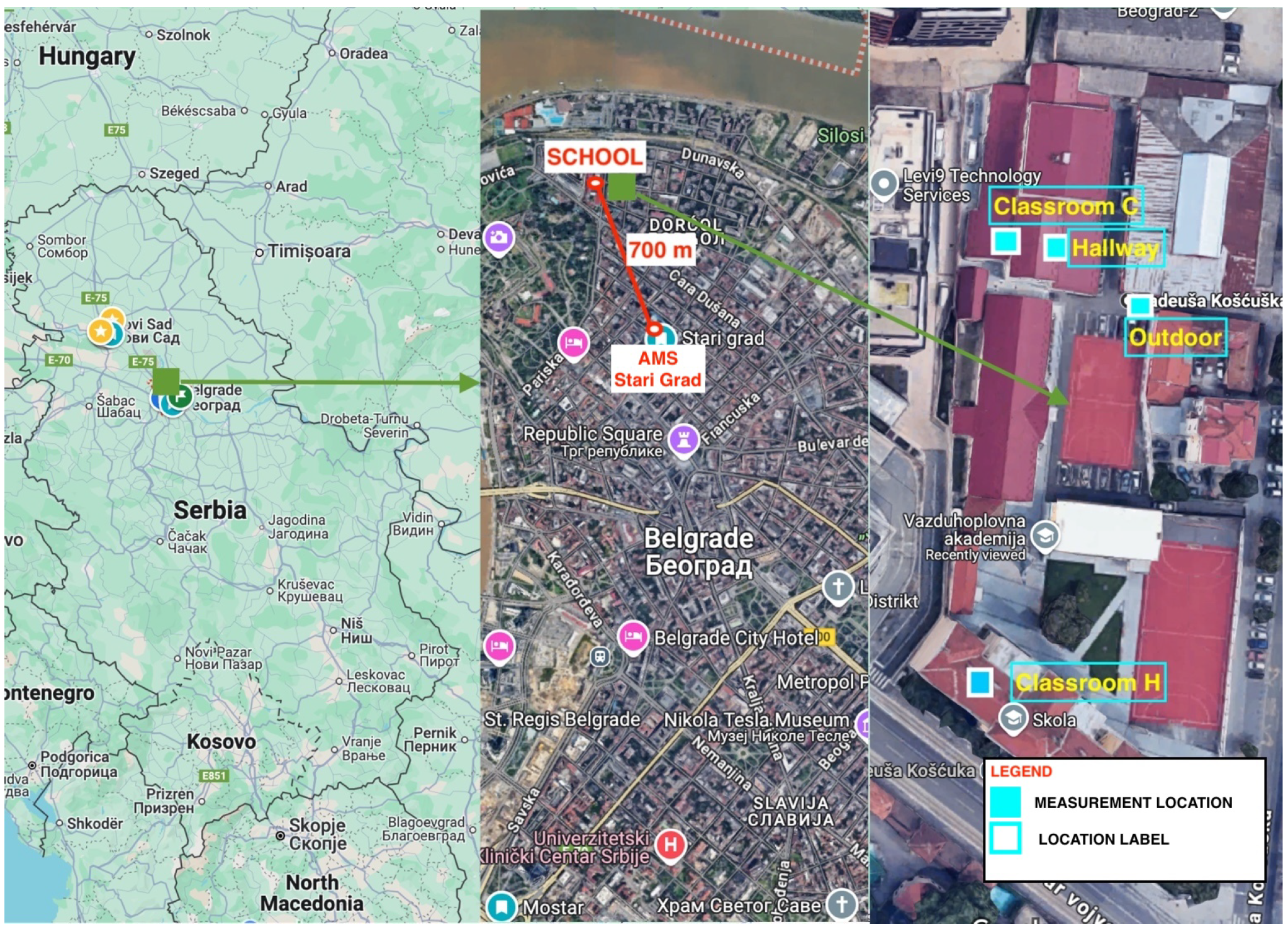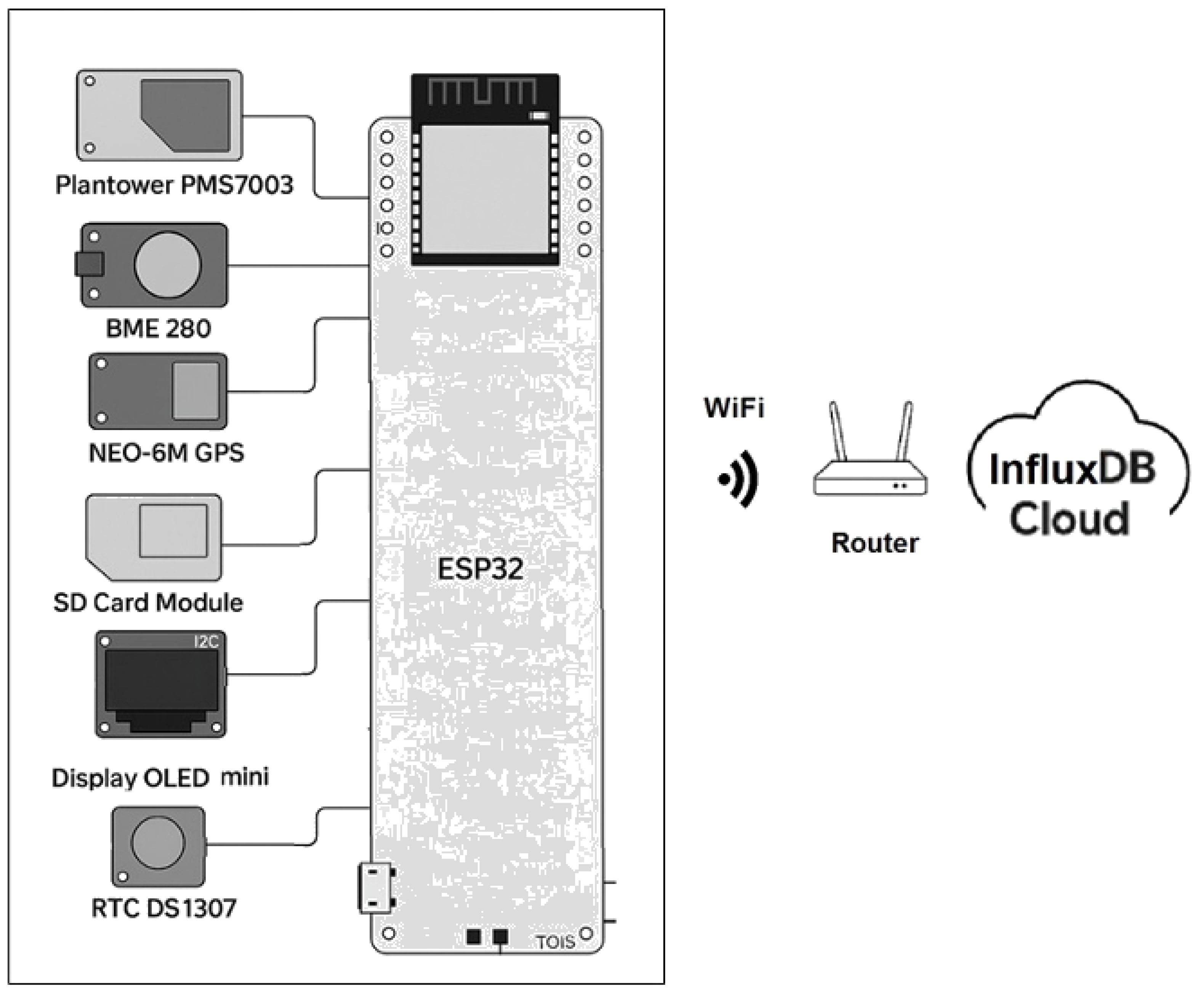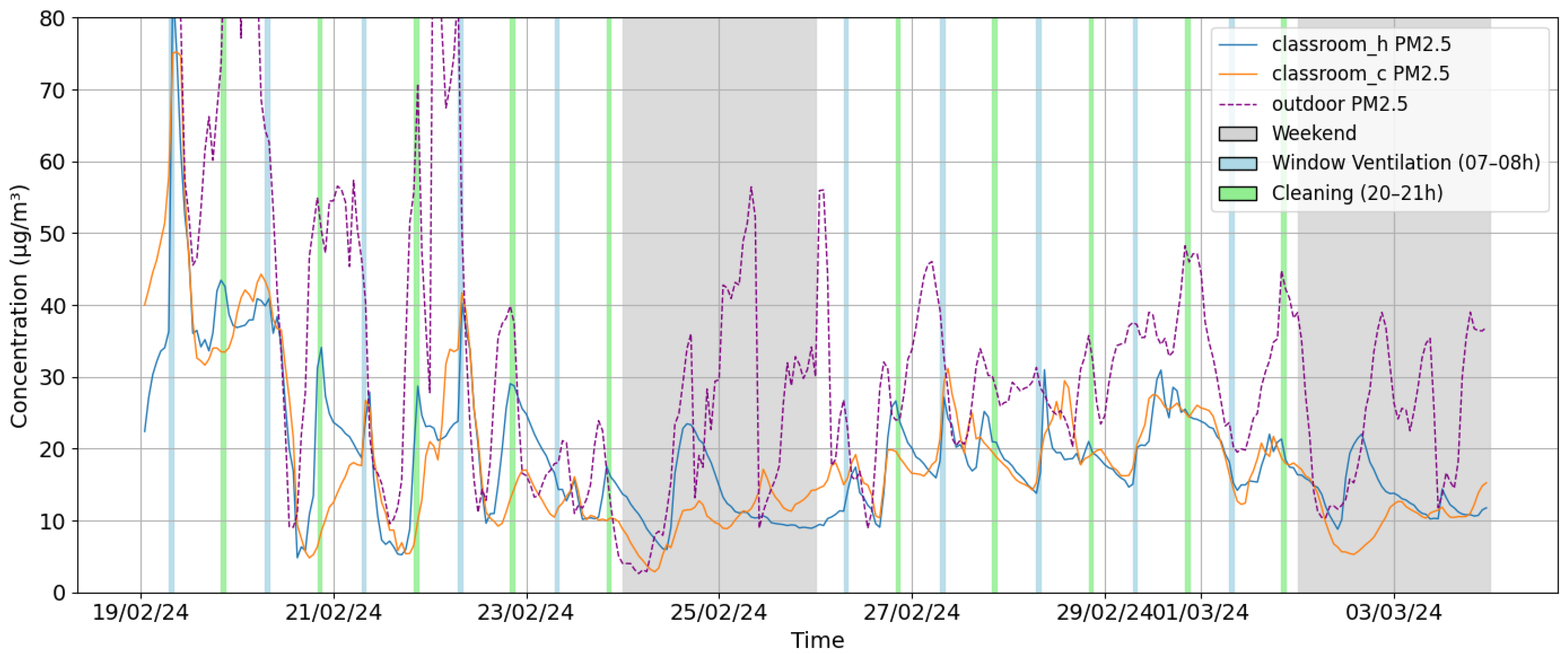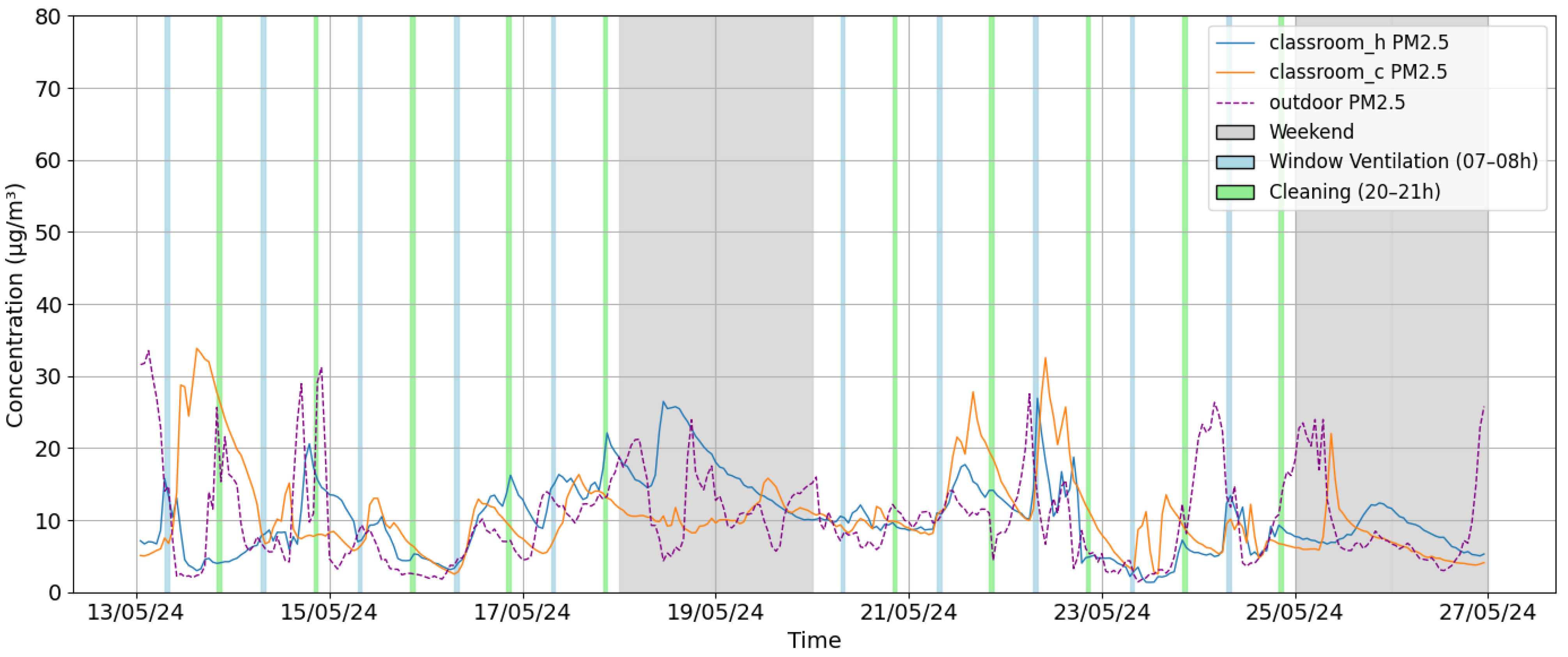1. Introduction
Particulate matter (PM), one of the major ambient air pollutants, consists of a complex mixture of solid and liquid particles suspended in the air, varying in size, shape, origin, and composition [
1]. The International Agency for Research on Cancer (IARC) classified PM as a Group 1 carcinogen, meaning it is carcinogenic to humans [
2].
Recent global assessments highlight the severe health burden of PM exposure. For example, ambient PM
2.5 has been associated with as many as 7 million all-cause deaths worldwide in 2012, and is a major risk factor for cardiovascular disease, respiratory infections, asthma, and premature mortality [
3]. A spatial mortality analysis in high-density Hong Kong districts further established a direct link between traffic-related PM emissions and district-level mortality rates [
4].
In school settings, adverse health effects can also be linked to PM exposure. A study conducted in primary schools identified associations between elevated levels of indoor PM
2.5, PM
10, formaldehyde, and worsened respiratory symptoms in children, including wheezing and increased asthma risk [
5]. These findings emphasize the particular vulnerability of children in educational settings, where prolonged exposure during critical developmental periods may compound health risks.
A considerable body of epidemiological research has evaluated the association between exposure to air pollution in school environments and children’s health outcomes. In recent years, systematic reviews have addressed diverse aspects of school-based air pollution: pollutant types, sources, and health impacts [
6,
7]. High PM concentrations have been consistently observed in school environments, particularly near busy roads and industrial sites [
8,
9,
10]. Studies often report higher indoor PM levels compared to outdoor ones [
8,
9,
10,
11,
12].
In the Republic of Serbia, research on indoor air pollution in schools and its effects on children’s health remains limited. Unlike the mandatory national programs for monitoring outdoor air quality, indoor environments are not comprehensively regulated by legislation, except in occupational environments. This gap reflects a broader global trend, where regulatory frameworks still predominantly address ambient air quality, although the interest in the indoor exposures has grown substantially in recent years [
13].
National air quality monitoring in Serbia is coordinated by the Serbian Environmental Protection Agency (SEPA), which operates a network of reference-grade stations across major cities [
14]. The Institute of Public Health of Belgrade also maintains several urban stations, providing complementary datasets on outdoor pollution. While these systems ensure reliable long-term data, their spatial coverage is limited, particularly near schools and educational facilities. Recent strategies [
15] acknowledge the need for broader monitoring, yet low-cost sensor networks remain excluded from official programs. Current deployments have mostly been research-driven or pilot initiatives, such as the UNICEF-supported project “Schools for Better Air Quality” [
16]. These experiences, along with recent scientific studies, demonstrate the feasibility of school-based low-cost sensor networks and their potential to complement reference infrastructure by delivering high-resolution exposure data relevant for protecting children’s health [
17]. Indoor air monitoring is primarily conducted through national and international research initiatives. Several studies have reported concentrations of respirable particulate matter in school environments [
18,
19,
20,
21,
22,
23].
Within the SEARCH project (2007–2009) [
13], which aimed to assess the relationship between school environments and children’s respiratory health, as well as to develop recommendations for improving indoor air quality, measurements were conducted in ten primary schools in Belgrade, encompassing a total of 44 classrooms. Parameters measured included indoor and outdoor temperature, relative humidity, carbon monoxide (CO), carbon dioxide (CO
2), nitrogen dioxide (NO
2), benzene, toluene, xylene, formaldehyde, and PM
10. The average PM
10 concentration in classrooms was 81 µg/m
3—comparable to those reported in Italy and Slovakia [
19]. All classrooms relied on natural ventilation, had high student occupancy, and were not equipped with air purification systems, thus representing realistic conditions of exposure. CO
2 levels served as reliable indicators of occupancy and of ventilation quality, with high concentrations correlating with poor ventilation and increased prevalence of respiratory symptoms. Consequently, the relationship between CO
2 and respiratory health should be interpreted as indirect rather than causal.
Similar studies conducted in Niš in 2010 and 2013—in a faculty building and a primary school—showed that indoor PM
10 concentrations were equal to or even higher than outdoor levels [
21]. A comparative study carried out during both the heating and non-heating seasons in two naturally ventilated schools—one located in an urban area and the other in a rural setting—revealed that CO
2 levels in classrooms regularly exceeded 1000 ppm during teaching hours. PM
2.5 concentrations frequently surpassed 25 µg/m
3 during the heating season, with a strong correlation between PM and CO
2 levels, underscoring the significant impact of occupancy and ventilation on indoor air quality [
22].
Another study [
24], conducted in a Belgrade kindergarten between March and May 2010, analyzed the composition of indoor and outdoor PM
2.5, focusing on polycyclic aromatic hydrocarbons (PAHs), metals, and ionic species. The daily indoor PM
2.5 concentrations ranged from 16.54 to 63.24 µg/m
3, while outdoor concentrations ranged from 14.63 to 97.60 µg/m
3, frequently exceeding WHO-recommended limits.
More recently, in 2021–2022, continuous year-long monitoring using low-cost sensors was performed in the cities of Bor and Niš [
25], along with targeted measurements conducted in a technical high school in Bor during the heating season [
26]. These studies observed elevated concentrations of PM
10 and PM
2.5 during teaching activities, which exceeded regulatory values on numerous days.
The influence of changes in smelting technology in the copper smelter in Bor, and seasonal changes on the level and chemical composition of PM
10 particles in a classroom at the Technical Faculty in Bor (Serbia) was analyzed by Radovic et al. [
27]. This study demonstrates that, despite changes in smelting technology, arsenic concentrations in PM
10 within a classroom remained elevated and close to outdoor levels, with indoor values nearly double the annual target. These findings emphasize the urgent need for enhanced emission control measures and improved building ventilation to prevent outdoor particle infiltration.
Collectively, findings from all studies indicate that students in Serbian schools are regularly exposed to elevated levels of particulate matter, particularly during the heating season and school hours. The key contributing factors include inadequate ventilation, particle resuspension due to movement, indoor sources such as furniture and heating appliances, and infiltration of polluted outdoor air. These results emphasize the need for systematic indoor air quality monitoring in schools and the implementation of preventive measures aimed at improving indoor microclimatic conditions.
In recent years, low-cost sensors have gained increasing importance in air-pollution monitoring due to their affordability and real-time data capabilities [
28,
29].
Recent advancements in affordable PM sensing technologies and monitoring networks have significantly improved the ability to observe PM concentrations in real time with high temporal granularity. Despite this progress, concerns remain regarding the reliability of such data, particularly in terms of agreement with standard reference-grade instruments. This issue is particularly important when low-cost monitors are used to support studies focused on health impacts, where data validity is critical. In general, the long-term performance and stability of most budget-friendly PM sensors are still not thoroughly characterized, with only a few commonly used models having been extensively evaluated [
30].
Most of these sensors function according to the Mie scattering principle [
31], employing semiconductor lasers as light sources. In these systems, the scattered light is directed—both directly and via mirrors—toward a photo detector within a measurement chamber [
32]. Technical specifications for several widely used low-cost sensors are compiled and discussed in [
32,
33], with additional commentary on their operational principles also available in the latter.
While traditional air quality monitoring stations offer high precision, they are expensive and limited in number, often located far from schools. In contrast, low-cost sensors, although less accurate, make it possible to measure air quality precisely where it matters most. Their low price enables broad deployment, even in schools with limited budgets, supporting the development of sensor networks that reflect actual environmental conditions experienced by children. Furthermore, integrating sensors into school settings offers educational value: students can actively participate in data collection, analysis, and interpretation, gaining scientific and technical skills while fostering environmental awareness.
However, for data from low-cost sensors to be reliable and actionable, proper calibration is essential. Due to their inherent measurement variability, these devices must be regularly compared with reference-grade instruments and recalibrated accordingly [
34]. Calibration ensures consistency, improves interpretability, and supports data-driven decision-making. Without proper calibration, measurements may be inaccurate or misleading, undermining trust in the system. Therefore, regular maintenance and quality control are crucial for their effective use. Implementing low-cost sensors in schools is not merely a technical intervention—it is a meaningful societal initiative toward building healthier, better-informed, and more responsible communities. Through such applications, schools transition from being solely learning institutions to becoming protectors of health and active drivers of change.
The justification for conducting this research in schools lies in the fact that educational institutions are often overlooked in urban air quality monitoring strategies, despite accommodating vulnerable populations in high-occupancy indoor spaces. Given the previous studies that have reported frequent exceedances of PM10 and PM2.5 reference values, in-school monitoring represents a scientifically grounded and socially relevant approach to identifying and addressing exposure to airborne micro-pollutants.
Systematic long-term studies of indoor and outdoor PM concentrations in schools are still scarce, with most previous investigations being short-term or limited in scope. In addition, very few studies have simultaneously monitored multiple micro-environments within a single school (e.g., classrooms, hallways, and outdoor reference sites), which is crucial for disentangling the roles of ventilation, occupancy, and outdoor infiltration. Furthermore, although the advantages and limitations of low-cost sensors (LCS) have been widely recognized, their performance in educational settings under real-world conditions has not yet been comprehensively validated against reference-grade instruments. Previous studies also reported that even when low-cost sensors were carefully calibrated against reference instruments prior to deployment, residual uncertainties remained due to their sensitivity to meteorological factors, particularly temperature and relative humidity.
To overcome these shortcomings, the present study conducted a multi-site (two classrooms, a hallway, and an outdoor station) and multi-season (winter and summer) monitoring campaign in a secondary school in Belgrade, Republic of Serbia. By combining measurements from low-cost PM sensors with reference instruments, the study provides novel insights into the seasonal variability of indoor/outdoor ratios, the impact of occupant activity and ventilation on PM levels, and the applicability of LCS for continuous school-based monitoring. Unlike previous investigations, this study explicitly addressed the influence of high relative humidity on measurement accuracy by integrating a humidity-filtering procedure during device calibration, thereby reducing uncertainty and improving data reliability. The system captures fine-scale spatial heterogeneity that national monitoring networks cannot resolve. This design highlights point-source differences within the same school building and enables the disentangling of indoor sources, outdoor infiltration, and human activity patterns. The specific aim of the study is to demonstrate the application of a real-time monitoring system for PM in a school environment. The system integrates low-cost sensors with a correction procedure based on co-location with reference instruments from the National Air Quality Monitoring Network, enabling real-time adjustment of measurement data. As an additional improvement over previous studies, this system eliminates humidity as a major source of error during sensor calibration, ensuring greater precision and enhancing the usability of the results for future research and air quality management.
In the context of schools, real-time monitoring is particularly valuable because children spend up to 6–8 h daily in classrooms and are more vulnerable to air-pollution exposure. Unlike periodic or short-term campaigns, real-time systems provide immediate feedback on pollution episodes, allowing school staff to take rapid actions such as opening windows, adjusting ventilation, or rescheduling activities. This feature makes the system not only a scientific tool but also a practical intervention supporting daily health protection of students.













